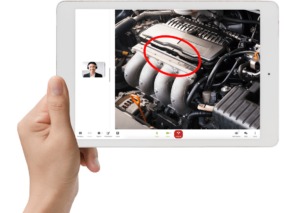Welcome to our latest iotum blog post, where we embark on a journey into the dynamic world of UCaaS (Unified Communications as a Service) and explore its ever-evolving landscape. In this post, we delve into the fascinating topic of the changing faces of UCaaS including the latest trends and advancements as well as where we see the Future of UCaaS heading.

Over the years, UCaaS has undergone a remarkable transformation, completely revolutionizing the way businesses communicate and collaborate.
We take a deep dive into the latest trends and advancements, discussing the following key areas:
1. The Shift Towards Cloud-Based Solutions:
Explore how businesses are increasingly adopting cloud-based UCaaS solutions, allowing for greater flexibility, scalability, and cost-effectiveness.
2. Integration of Artificial Intelligence and Machine Learning:
Discover how AI and machine learning technologies are being integrated into UCaaS platforms, enhancing communication efficiency and enabling personalized user experiences.
3. Emergence of Cutting-Edge Features:
Learn about the exciting emergence of innovative features such as team collaboration tools and video conferencing, empowering teams to collaborate seamlessly across different locations.
Join us as we unravel the exciting possibilities and explore how UCaaS continues to shape the future of modern communication in our blog post.
The latest trends and advancements in UCaaS:
1. Cloud-Based Solutions:
UCaaS has witnessed a significant shift towards cloud-based solutions, offering businesses greater flexibility, scalability, and cost-effectiveness. Organizations are embracing the cloud for their communication needs, allowing them to access UCaaS platforms from anywhere, anytime, and across various devices. 
2. Integration of Artificial Intelligence (AI) and Machine Learning (ML):
AI and ML technologies are increasingly being integrated into UCaaS platforms, enhancing communication and collaboration experiences. Intelligent virtual assistants, speech recognition, and natural language processing capabilities are being used to automate tasks, provide personalized experiences, and enable smart routing of calls and messages.
3. Team Collaboration Tools:
UCaaS platforms now include robust team collaboration tools that facilitate seamless communication and collaboration among employees. These tools combine features like instant messaging, file sharing, task management, and video conferencing, enabling teams to work together efficiently, irrespective of geographical boundaries.
4. Video Conferencing Evolution:
Video conferencing capabilities in UCaaS have evolved significantly, offering high-definition video and audio experiences. Modern UCaaS solutions integrate with popular video conferencing platforms, enabling multi-party video calls, screen sharing, and virtual backgrounds. Additionally, advancements in bandwidth availability and video compression technologies have made video conferencing smoother and more reliable.
5. Mobile Optimization and Accessibility:
UCaaS providers are focusing on optimizing their platforms for mobile devices, recognizing the growing importance of mobile communication. Mobile apps allow users to access UCaaS features on their smartphones and tablets, enabling them to stay connected and productive while on the go.

6. Security and Data Privacy:
With the increasing reliance on UCaaS platforms, ensuring robust security and data privacy has become crucial. Providers are implementing advanced encryption, secure protocols, and compliance with regulations like GDPR (General Data Protection Regulation) to protect sensitive communication and user data.
7. APIs and Integration Capabilities:
UCaaS platforms are incorporating open APIs (Application Programming Interfaces), enabling seamless integration with other business applications. This integration facilitates workflow automation, data sharing, and better collaboration across various tools and systems.
The Future of UCaaS:
1. Advanced AI-powered Virtual Assistants:

UCaaS platforms will feature more sophisticated AI-powered virtual assistants capable of handling complex tasks, scheduling meetings, providing real-time language translation, and even analyzing sentiment during conversations. These virtual assistants will become an integral part of daily business communication, making interactions more efficient and personalized.
Use Case Example:
For instance, imagine a scenario where a professional needs to schedule a meeting with team members across different time zones. With an AI-powered virtual assistant integrated into the UCaaS platform, they can simply use voice commands to request the assistant to find suitable time slots, invite participants, and even book conference rooms based on availability. The virtual assistant intelligently handles the logistics, taking into account everyone’s schedules, preferences, and time zone differences, ultimately saving time and effort for the user. You could even tell your virtual assistant to attach documents, create a poll and send followups.
2. Seamless Integration with IoT:
UCaaS will seamlessly integrate with the Internet of Things (IoT), enabling communication and collaboration with connected devices. This integration will allow users to control conference room equipment, access unified messaging on smartwatches, and leverage IoT data to enhance contextual communication experiences.
Enhanced Device Connectivity:
In the next five years, UCaaS will integrate seamlessly with IoT devices, enabling businesses to communicate and collaborate with a wide range of connected devices. This integration will extend beyond traditional communication endpoints (e.g., phones and computers) to include IoT-enabled devices such as smart displays, sensors, wearables, and even smart appliances.
Contextual Communication:
By leveraging IoT data, UCaaS platforms will provide contextual communication experiences. For example, during a video conference, participants’ wearable devices could transmit real-time health metrics, enabling health-conscious individuals or healthcare professionals to monitor vital signs or wellness indicators during a meeting.
Smart Meeting Rooms:
UCaaS and IoT integration will revolutionize meeting room experiences. IoT sensors embedded in meeting spaces will collect data on occupancy, room temperature, lighting conditions, and even air quality. This information can be used to optimize the meeting environment automatically or provide insights for future space utilization planning.
Unified Messaging on IoT Devices:
UCaaS platforms will extend their reach to IoT devices, allowing users to access unified messaging features on smartwatches, smart speakers, and other IoT devices. Users will be able to receive and respond to messages, join conference calls, and collaborate on projects directly from their IoT devices, eliminating the need for constant device switching.
IoT Data-driven Communication:
Integration with IoT will enable UCaaS platforms to leverage data generated by IoT devices for intelligent communication. For example, if a connected manufacturing machine encounters an issue, it can trigger automated notifications to relevant team members via UCaaS channels, ensuring prompt response and issue resolution.
Voice-enabled IoT Communication:
With UCaaS and IoT integration, voice-enabled communication will become more prevalent. Users will be able to initiate calls, join meetings, and perform various communication tasks using voice commands, thanks to integration with voice-activated IoT devices like smart speakers or voice assistants.
IoT-driven Automation and Workflows:
UCaaS platforms will collaborate with IoT devices to enable automation and streamlined workflows. For instance, when a customer places an order, IoT sensors in a warehouse can trigger automated notifications to the relevant teams through UCaaS, initiating the order fulfillment process seamlessly.
3. Augmented Reality (AR) and Virtual Reality (VR) Integration:
UCaaS will embrace AR and VR technologies, transforming the way people collaborate remotely. Users will be able to participate in immersive virtual meetings, share and manipulate 3D models, and create lifelike virtual environments for enhanced communication and collaboration.
Virtual Meetings and Collaboration:
In the future, UCaaS platforms could incorporate AR and VR technologies to enable virtual meetings and collaboration experiences. Users will be able to join immersive virtual environments where they can interact with lifelike avatars of their colleagues, clients, or partners. This level of immersion will create a sense of presence, making remote collaboration feel more natural and engaging.
3D Model Sharing and Manipulation:
AR and VR integration in UCaaS will facilitate the sharing and manipulation of 3D models during meetings and presentations. Participants can visualize and interact with 3D objects in real-time, enhancing understanding and enabling better collaboration in fields like product design, architecture, and engineering.
Use Case Example:
Imagine an architectural firm using a UCaaS platform with AR and VR capabilities to collaborate with clients and project stakeholders. Instead of relying solely on traditional 2D drawings and renderings, the firm can create virtual environments where clients can explore and experience architectural designs in a more immersive and realistic manner.
Using AR, clients can view physical spaces through their smartphones or tablets and overlay virtual architectural models onto the real-world environment. They can walk through virtual representations of buildings, change materials or finishes in real-time, and even visualize how natural lighting will affect the space.
For more immersive experiences, the firm can leverage VR technology. Clients can wear VR headsets to step into fully immersive virtual environments, where they can interact with and manipulate 3D models of buildings. They can explore different floor plans, room layouts, and interior designs, giving them a realistic sense of the final product before construction even begins.
This integration of AR and VR in UCaaS platforms revolutionizes the architectural design and client collaboration process. It enables more effective communication between architects, clients, and other stakeholders, as everyone can visualize and understand the design intent in a more tangible and interactive way. It also helps identify potential design issues or modifications early on, reducing the need for costly changes during construction.
Virtual Training and Simulations:
UCaaS platforms with AR and VR capabilities will enable organizations to conduct virtual training sessions and simulations. Employees can immerse themselves in virtual environments to learn new skills, practice complex tasks, and undergo realistic simulations, all without the need for physical presence or expensive equipment.
Remote Assistance and Support:
AR integration within UCaaS platforms will allow users to receive real-time remote assistance and support. Through AR-enabled devices like smart glasses, users can share live video feeds of their environment with experts who can overlay helpful information, instructions, or annotations, enabling efficient troubleshooting and guidance.
Enhanced Data Visualization:
AR and VR technologies will enable the visualization of complex data sets in intuitive and immersive ways. Users can interact with data visualizations in three-dimensional space, gaining deeper insights and making data-driven decisions more effectively. 
Virtual Conferencing Spaces:
UCaaS platforms may create virtual conferencing spaces that simulate physical meeting rooms or event venues. Participants can join these spaces using VR headsets, where they can interact, share content, and engage in discussions as if they were physically present, fostering more engaging and interactive remote meetings.
Enhanced Remote Collaboration:
AR and VR integration will promote more seamless remote collaboration by providing spatial audio, realistic gestures, and visual cues. This level of immersion and interactivity will enhance communication, collaboration, and teamwork, regardless of geographical distances.
4. Enhanced Data Analytics and Insights:
UCaaS platforms will leverage advanced data analytics capabilities to provide actionable insights into communication patterns, productivity trends, and team performance. Real-time analytics will enable businesses to make data-driven decisions, optimize workflows, and improve overall efficiency.
5. Intelligent Automation and Workflow Orchestration:
Automation will play a crucial role in UCaaS, streamlining repetitive tasks, and orchestrating workflows across multiple applications and systems. Intelligent automation tools will integrate with UCaaS platforms to automate processes, reduce human error, and improve productivity.
6. Multi-Modal Communication Experiences:
UCaaS will offer seamless multi-modal communication experiences, combining voice, video, chat, and collaboration tools. Users will be able to switch between different modes of communication effortlessly, enhancing flexibility and adaptability in diverse work scenarios.
7. Enhanced Security and Privacy Measures:
As UCaaS continues to evolve, security and privacy measures will become even more robust. Encryption, secure authentication, and data protection protocols will be further strengthened to ensure the confidentiality and integrity of communications, addressing growing concerns around cyber threats.
Ready to embrace the future of modern communication with UCaaS? Visit iotum.com today and discover how our UCaaS solutions can empower your business. Experience the benefits of cloud-based communication, AI integration, cutting-edge features, and seamless collaboration across devices. Let us help you shape the future of communication in your organization. Contact us now to get started!

